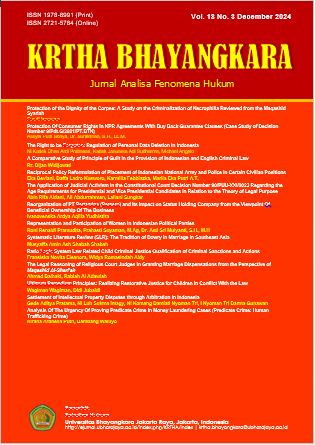Commercial Court Rulings on PKPU and Bankruptcy: the Ratio Decidendi in Balancing Creditor and Debtor Rights
DOI:
https://doi.org/10.31599/krtha.v19i1.3739Keywords:
Bankruptcy, PKPU, Ratio Decidendi, Commercial Court, Debt Restructuring, Legal CertaintyAbstract
The bankruptcy of PT Sri Rejeki Isman Tbk (Sritex), one of Indonesia’s largest textile companies, attracted public and legal scrutiny due to its debt burden of approximately IDR 19 trillion. The ruling issued by the Commercial Court in this case reflects the ongoing challenge of balancing the legal interests of creditors and debtors—particularly in determining whether debt restructuring under a Suspension of Debt Payment Obligations (PKPU) is still feasible or whether bankruptcy constitutes the only legal recourse. This article examines the ratio decidendi applied by the Commercial Court in Sritex’s bankruptcy ruling, identifies the legal reasoning patterns used by judges, and evaluates the implications of such rulings for legal certainty and business practice in Indonesia. A normative juridical method is applied, supported by jurisprudential analysis and comparative assessment of similar bankruptcy cases, including Garuda Indonesia and Duniatex.The results show that the court’s decision in the Sritex case prioritizes legal certainty for creditors while leaving unresolved questions about restructuring opportunities for debtors and the continuity of business operations. The findings underscore the urgency of reforming PKPU mechanisms to become more flexible, thereby enabling companies with viable prospects to pursue restructuring prior to bankruptcy declarations.
References
Aditya Pratama, G. A. (2021). Hilangnya tes insolvensi sebagai syarat kepailitan di Indonesia. Krtha Bhayangkara, 15(1), 1–10. https://doi.org/10.31599/krtha.v15i1.450
Fauzi, M. (2018). Insolvency within bankruptcy: The case in Indonesia. SHS Web of Conferences, 54, 06004. https://doi.org/10.1051/SHSCONF/20185406004
Fredy, H., Utami, K., & Pagiku, M. (2024). Debt restructuring and financial performance SOEs in Indonesia. Journal of Economics, Finance and Management Studies, 7(5), 777–783. https://doi.org/10.47191/jefms/v7-i5-61
Johan, S., Sudiro, A., Gunadi, A., & Luo, Y. (2022). Rethinking indebtedness according to the principles of justice and equality. Lex Scientia Law Review, 6(2), 134–150. https://doi.org/10.15294/lesrev.v6i2.55011
Megawaty, R., & Pakpahan, E. (2020). Legal settlement efforts that should be done by Indonesia and Singapore in completing debt by curators to creditors through bankruptcy. Proceedings of the International Conference on Culture Heritage, Education, Sustainable Tourism, and Innovation Technologies, 486–493. https://doi.org/10.5220/0010326004860493
Napitupulu, H. (2020). Voluntary bankruptcy petition dalam perspektif prinsip commercial exit from financial distress. Krtha Bhayangkara, 14(1), 51–69.
Putra, F. R. (2021). Reform of plan termination in suspension of debt payment obligations (PKPU) in Indonesia. Yuridika, 36(3), 443–464. https://doi.org/10.20473/ydk.v36i3.30295
Rahmawati, R. (2019). Comparison of laws for settling debt remaining bankruptcy between Indonesian and Dutch countries. Jurnal Nasional, 4(1), 18–26. https://doi.org/10.22225/JN.4.1.895.18-26
Rachmadi, T. Y., & Abbas, Y. (2024). Evaluation of tax debt management for bankrupt taxpayers in Indonesia. Journal of Multidisciplinary Academic Business Studies, 1(4), 110–118. https://doi.org/10.35912/jomabs.v1i4.2210
Robert, R., Agustina, R., & Nasution, B. (2021). Punishing the bankruptcy fraudsters: What can Indonesia learn from the United States of America? Jurnal Dinamika Hukum, 20(1), 12–27. https://doi.org/10.20884/1.JDH.2020.20.1.2874
Simaremare, S., Nasution, B., Sunarmi, S., & Yunara, E. (2021). Comparison of legal systems: Legal studies on postponement of debt payment obligations in Indonesia and reorganization in the United States. Proceedings of the 2nd International Conference on Law, Economic, Governance (ICOLEG 2021). https://doi.org/10.4108/eai.29-6-2021.2312656
Simaremare, P. S., Nasution, B., Sunarmi, & Yunara, E. (2021). Reviewing the comparison of the legal bankruptcy system between Indonesia and the Netherlands. Turkish Journal of Computer and Mathematics Education, 12(6), 1250–1262. https://doi.org/10.17762/turcomat.v12i6.4834
Syaifullah, I., & Megantoro, S. S. (2021). Ruling due to bankruptcy assets debtors beyond areas in Indonesia. Lambung Mangkurat Law Journal, 6(1), 1–11. https://doi.org/10.32801/lamlaj.v6i1.201
Toha, K., & Retnaningsih, S. (2020). Legal policy granting status of fresh start to the individual bankrupt debtor in developing the bankruptcy law in Indonesia. Academic Journal of Interdisciplinary Studies, 9(3), 157–167. https://doi.org/10.36941/ajis-2020-0033
Undang-Undang Nomor 37 Tahun 2004 tentang Kepailitan dan Penundaan Kewajiban Pembayaran Utang (PKPU).
Yitawati, K., Sulistiyono, A., & Pujiyono, P. (2023). Reconstructing the debt restructuring mechanism in the Indonesian law on bankruptcy and suspension of debt payment obligations. Financial Engineering, 1(8), 81–95. https://doi.org/10.37394/232032.2023.1.8
Yonatan, Y., Sugiri, B., Sukarmi, S., & Sulistio, F. (2023). Selection of methods of proving the inability of debtors to pay debts and the application of prejudice against misuse of insolvency institutions in insolvency law in Indonesia. International Journal of Environmental, Sustainability, and Social Science, 4(2), 106–120. https://doi.org/10.38142/ijesss.v4i2.524
Downloads
Published
Issue
Section
License
Copyright (c) 2025 Selamat Lumban Gaol, Istianingsih Sastrodiharjo

This work is licensed under a Creative Commons Attribution 4.0 International License.















